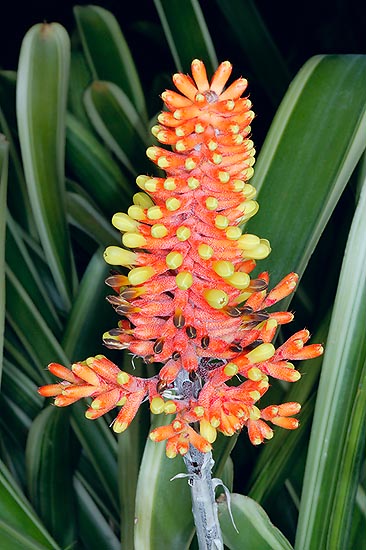Family : Bromeliaceae

Text © Pietro Puccio

English translation by Mario Beltramini

The showy inflorescence can be 80 cm long © Giuseppe Mazza
The name of the genus comes from the Greek “aichme” = spearhead, with reference to the thorny apexes of the sepals and of the floral bracts; the name of the species is the Latin name “caudata” = with tail, with reference to the appearance of the lower bracts of the inflorescence.
Common names: “tail bromeliad” (English).
Evergreen, herbaceous, plant, monocarpic (bearing fruit only one time during its existence), acaulescent, epiphytic or saxicolous, tall about 1 m (inflorescence included), it has a funnel-shaped rosette of rigid ribbon leaves, arcuated, of pale green colour, long up to about 70 cm and 6-8 cm broad, with the margins provided of 1 mm long thorns and rounded thorny apex; the leaves form at the centre a cavity usually filled up with water.
The inflorescence, long even 80 cm, is formed by the floral scape covered by a white tomentum ending in a spike, composite in the lower half, simple in the upper one, 20-25 cm long; the inferior bracts of the spike are lanceolate-linear, 5-8 cm long, of a lilac-pink colour with small greyish scales, the floral bracts are about 15 mm long, triangular, lilac-pink with small greyish scales and thorny apex. The individual flowers have 5 mm long sepals with sharp apex and yellow, 15 mm long, petals, and a woolly, white ovary which becomes yellow when ripe, the flowers open in sequence for a duration of about 40-45 days. The plant is self-incompatible, it needs, therefore, a crossed pollination for fructifying; the fruit is an orange berry.
It easily reproduces by vegetative way through the new plants which come out from axillary gemmae between the leaves, which can be detached when they have reached a size of at least one third of the mother plant. Plant cultivable both as epiphytic and as terrestrial in the tropical and subtropical climates in full sun or, better, under slight shade, as edge or for covering the soil, in particular in its most cultivated variety, the Aechmea caudata ‘Variegata’ (see photo), which has bright green leaves, edged and covered by cream-white longitudinal stripes. The plant and the varieties are both robust, resistant to the wind and to the marine aerosols and even if they come mainly from humid habitats, they can resist also to periods of drought. It can be cultivated in open air marginally also in the warm temperate climates, as it bears, for a very short time, temperatures as low as -3/-4°C, even if with damage to the foliage; in these situations it resists better if sheltered from the winter rains, seen that the humidity and the low temperatures render it more sensitive to rottenness.
Cultivated in pot, it is utilized for indoor decoration, luminous verandas and winter gardens, in very luminous position and on a draining substratum, very porous and aerated which can be formed with peat and sand or other inert materials (agri-perlite, vermiculite, etc.), with temperatures which is good to keep over the 14°C, best 18-22°C. In summer the substratum is to be kept slightly humid, and some water is to be left at the centre of the rosette if the temperatures are over the 18°C, with lower temperatures, there is the risk of formation of rottenness; in presence of very calcareous water, in order to avoid anti-estethic deposits at the centre of the rosette, demineralised water is to be utilized, renewing the same frequently in summer and in the warm climates for avoiding that it becomes a larval centre for mosquito.
Synonyms: Hoplophytum platzmannii E.Morren (1875); Hoplophytum luteum E.Morren ex Baker (1889); Aechmea henningsiana Wittm. (1891); Aechmea platzmannii Wittm. (1891); Aechmea caudata var. variegata M.B.Foster (1953); Aechmea caudata f. albiflora W.Weber & Roeth (1982); Ortgiesia caudata (Lindm.) L.B.Sm. & W.J.Kress (1989); Ortgiesia caudata f. albiflora (W.Weber & Roeth) L.B.Sm. & W.J.Kress (1989).
→ For general notions about BROMELIACEAE please click here.
